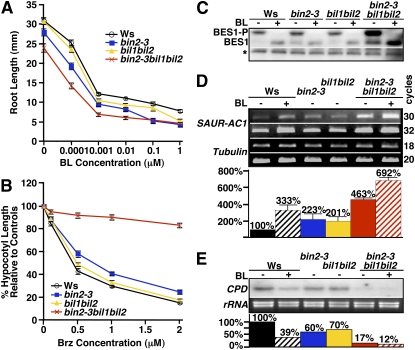Figure 5.
Physiological, biochemical, and molecular analyses of the T-DNA insertional mutations of BIN2, BIL1, and BIL2. A, Average root lengths of 2-week-old seedlings of the Ws wild type, bin2-3, bil1bil2, and bin2-3bil1bil2 mutants grown on half-strength MS medium containing no or increasing concentrations of BL. B, Hypocotyl elongation of the wild type, bin2-3, bil1bil2, and bin2-3bil1bil2 mutants grown on medium containing no or increasing concentrations of Brz. Inhibition of hypocotyl elongation by Brz is expressed relative to the average hypocotyl length of the same genotype grown on regular half-strength MS medium. For both A and B, each data point represents an average of 60 seedlings of two duplicate experiments. Error bars represent se. C, Western-blot analysis of BES1 phosphorylation status in BL- or mock-treated seedlings. Total proteins were extracted with 2× SDS buffer, separated by 10% SDS-PAGE, and analyzed by western blotting with anti-BES1 antibody. BES1-P is the phosphorylated BES1, and the asterisk indicates a nonspecific band used for a loading control. D, RT-PCR analysis of SAUR-AC1 expression. The numbers on the right represent numbers of PCR cycles. RT-PCR gel images were analyzed by ImageJ (version 1.3.7) to determine the signal intensity of individual bands. The expression level of SAUR-AC1 in the bar graph was expressed as a percentage of the ratio of the SAUR-AC1 transcript abundance versus the β-TUBULIN transcript level relative to that of the mock-treated Ws wild-type control. Each data bar represents an average of three independent RT-PCR experiments, and error bars denote se. E, Northern blot analysis of CPD gene expression. Ethidium bromide-stained rRNAs were used as a loading control. The autoradiograph was photographed and analyzed by ImageJ (version 1.3.7; http://rsb.info.nih.gov/ij/). The signal intensity of each CPD band in the bar graph below is expressed as a percentage relative to that of mock-treated Ws wild-type seedlings.

